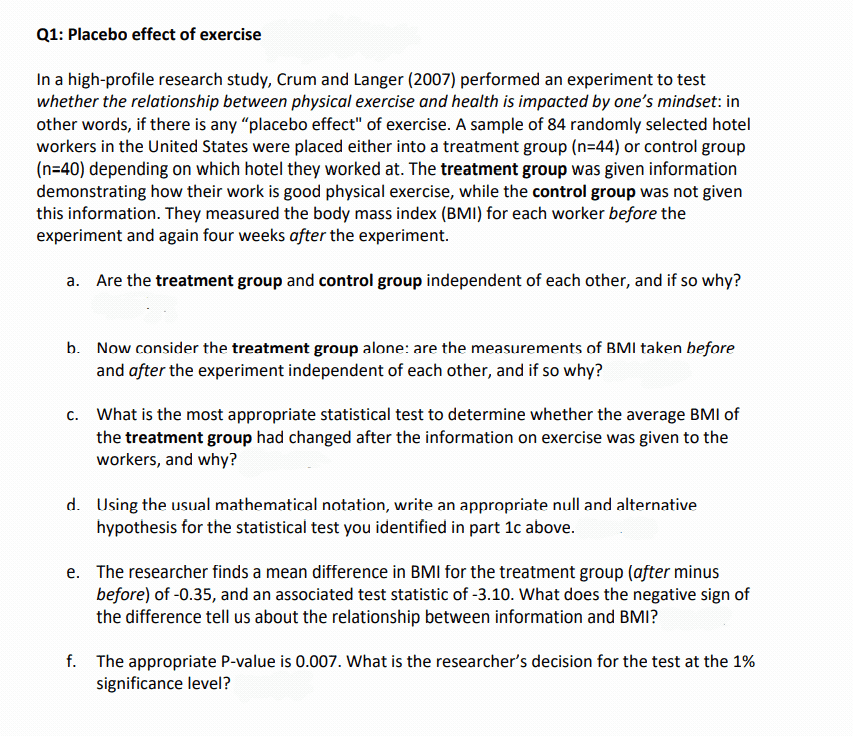Q1: Placebo effect of exercise In a high-profile research study, Crum and Langer (2007) performed an experiment to test whether the relationship between physical exercise and health is impacted by one's mindset: in other words, if there is any "placebo effect" of exercise. A sample of 84 randomly selected hotel workers in the United States were placed either into a treatment group (n=44) or control group (n=40) depending on which hotel they worked at. The treatment group was given information demonstrating how their work is good physical exercise, while the control group was not given this information. They measured the body mass index (BMI) for each worker before the experiment and again four weeks after the experiment. a. Are the treatment group and control group independent of each other, and if so why? b. Now consider the treatment group alone: are the measurements of BMI taken before and after the experiment independent of each other, and if so why? c. What is the most appropriate statistical test to determine whether the average BMI of the treatment group had changed after the information on exercise was given to the workers, and why? d. Using the usual mathematical notation, write an appropriate null and alternative hypothesis for the statistical test you identified in part 1c above. e. The researcher finds a mean difference in BMI for the treatment group (after minus before) of -0.35, and an associated test statistic of -3.10. What does the negative sign of the difference tell us about the relationship between information and BMI? f. The appropriate P-value is 0.007. What is the researcher's decision for the test at the 1% significance level?
Q1: Placebo effect of exercise In a high-profile research study, Crum and Langer (2007) performed an experiment to test whether the relationship between physical exercise and health is impacted by one's mindset: in other words, if there is any "placebo effect" of exercise. A sample of 84 randomly selected hotel workers in the United States were placed either into a treatment group (n=44) or control group (n=40) depending on which hotel they worked at. The treatment group was given information demonstrating how their work is good physical exercise, while the control group was not given this information. They measured the body mass index (BMI) for each worker before the experiment and again four weeks after the experiment. a. Are the treatment group and control group independent of each other, and if so why? b. Now consider the treatment group alone: are the measurements of BMI taken before and after the experiment independent of each other, and if so why? c. What is the most appropriate statistical test to determine whether the average BMI of the treatment group had changed after the information on exercise was given to the workers, and why? d. Using the usual mathematical notation, write an appropriate null and alternative hypothesis for the statistical test you identified in part 1c above. e. The researcher finds a mean difference in BMI for the treatment group (after minus before) of -0.35, and an associated test statistic of -3.10. What does the negative sign of the difference tell us about the relationship between information and BMI? f. The appropriate P-value is 0.007. What is the researcher's decision for the test at the 1% significance level?
Holt Mcdougal Larson Pre-algebra: Student Edition 2012
1st Edition
ISBN:9780547587776
Author:HOLT MCDOUGAL
Publisher:HOLT MCDOUGAL
Chapter11: Data Analysis And Probability
Section: Chapter Questions
Problem 8CR
Related questions
Question

Transcribed Image Text:Q1: Placebo effect of exercise
In a high-profile research study, Crum and Langer (2007) performed an experiment to test
whether the relationship between physical exercise and health is impacted by one's mindset: in
other words, if there is any "placebo effect" of exercise. A sample of 84 randomly selected hotel
workers in the United States were placed either into a treatment group (n=44) or control group
(n=40) depending on which hotel they worked at. The treatment group was given information
demonstrating how their work is good physical exercise, while the control group was not given
this information. They measured the body mass index (BMI) for each worker before the
experiment and again four weeks after the experiment.
a. Are the treatment group and control group independent of each other, and if so why?
b. Now consider the treatment group alone: are the measurements of BMI taken before
and after the experiment independent of each other, and if so why?
c. What is the most appropriate statistical test to determine whether the average BMI of
the treatment group had changed after the information on exercise was given to the
workers, and why?
d. Using the usual mathematical notation, write an appropriate null and alternative
hypothesis for the statistical test you identified in part 1c above.
e. The researcher finds a mean difference in BMI for the treatment group (after minus
before) of -0.35, and an associated test statistic of -3.10. What does the negative sign of
the difference tell us about the relationship between information and BMI?
f. The appropriate P-value is 0.007. What is the researcher's decision for the test at the 1%
significance level?
Expert Solution
This question has been solved!
Explore an expertly crafted, step-by-step solution for a thorough understanding of key concepts.
Step by step
Solved in 2 steps

Recommended textbooks for you

Holt Mcdougal Larson Pre-algebra: Student Edition…
Algebra
ISBN:
9780547587776
Author:
HOLT MCDOUGAL
Publisher:
HOLT MCDOUGAL


Holt Mcdougal Larson Pre-algebra: Student Edition…
Algebra
ISBN:
9780547587776
Author:
HOLT MCDOUGAL
Publisher:
HOLT MCDOUGAL
